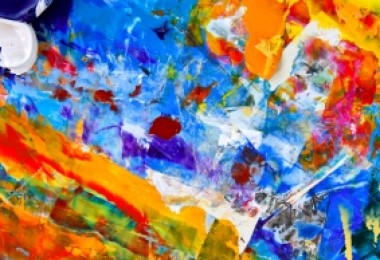Translation Romani has decided to maintain use of the word Romani in all language versions of this website, inclusively and in reference both to the language and people of all the diverse ethnic communities throughout the world, i.e. Roma, Sinti, Manuš, Calé, Romanichal, Kalé, and many others. Please read the important notes from our translators for explanations and other translations currently in use locally, nationally or regionally.
Close this box.
Visual Arts is a term that embodies various artistic forms, including drawing, painting, sculpture, design, and most recently, new media (and computer) art. There are many different types and genres of visual art historically, ranging from the fine art of the academies and religious art, to decorative arts and new media installations. A combination of beauty aesthetics, intellectual thought , and mastery of skills has traditionally conferred the status of "art" to an object. Within different traditions (cultures and historical periods), the criteria for defining art have varied. Art historians and critics have often differentiated "fine arts" from the category of "arts and crafts", where the latter implies prioritization of functionality and utilitarian objectives over an abstract intellectual, creative idea or concept. Ideologies supported by institutions and patronage have historically determined aesthetic standards. Likewise, historical events (wars, violence and economic realities) transform established relationships of art to the world. In the late 20th c., postmodernism redefined "meaning" in art, moving it from objective to subjective. Thus, in much contemporary art, the value of a created work emerges in conjunction with the participation of the viewers, whose attitudes and personal experiences contribute to creating a meaningful artistic experience. In a contemporary world that is increasingly mediated by visual culture through technologies, visual art studies seeks to understand artistic production not only in terms of social and political histories but also as a semiotics of the visual, one that includes understanding the relevance of the image to representation. This has entailed rethinking the notion of visual literacy, which defines how viewers recognize, interpret and analyze, i.e. "read", a wide range of images.
After decades of being represented culturally by others, Romani visual artists are now starting to be admitted into official, institutional world culture on their own terms. As artists, they exercise their legitimate right to choose whether or not their artistic creations will ultimately focus on consciously representing facets of Romani culture or simply be informed by the Romani identities that are a part of their lives and experiences. As is the case for other traditionally underrepresented ethnic and cultural communities in the international market, Romani artists nevertheless continue to struggle with the knowledge that others viewing their work expect to find anthropological or ethnographic portraits of little known or misunderstood aspects of Romani culture. Romani art, however, varies according to the unique artistic visions of each individual, even while reflecting, to varying degrees, the multiple linguistic, cultural and historical dimensions that contitute Romani experience globally. These include depictions of experiences like the Porrajmos, discrimination and persecution, and symbols associated with Indian origins, travel and nomadism. Well-known Romani artists include: Ceija Stojka (Austria), a Stojka family survivor of the Holocaust, Karlis Rudevics (Latvia), Gabi Jimenez (France), János Balázs (Hungary), István Szentandrássy (Hungary), Daniel Baker (England), Katarzyna Pollok (Ukraine/Poland), Sandra Jayat (Italy), Bruno Morelli (Italy), and Helios Gómez (Spain). Hungarian painter Zoltán Ádám has acquired fame from his series of Romani portraits, and Hungarian Romani Tímea Junghaus has written about Romani painters from an art historical perspective. Most recently, the Romani pavillion at the Biennale di Venezia (2007) became a venue for some Romani artists. Many Romani painters and visual artists also write creatively, especially poetry. In Canada, Romani artist Lynn Hutchinson Lee is well-known for her artwork and poetry, and will participate with Romani writer Hedina Sijerčić and others in "Call the Witness" at the Second Roma Pavillion of the Biennale di Venezia in 2011.
References:
ACB Galéria (ed), Ádám, Zoltán. Festmények-Akvarellek-Rajzok. 2002-2004, Budapest (2004).
Cigány Kulturális és Közművelődési Egyesület (ed), Alkotások Az - Erdős Kamill Cigány Múzeum - Képzőművészeti Anyagából, Pécs (2005).
Courthiade, Marcel (ed), "Un peintre rrom de Hongrie: Balázs, János (1905-1977)", Missives (Paris: Société littéraire de La Poste et de France Télécom, 2002) (225) 48-49.
Kerékgyártó, István (2007), Szentandrássy István, Budapest: L`Harmattan Kiadó / Kossuth Klub.
ROMBASE, "Personalities", University of Graz, Austria. Available online.
Stoffers, Nina, "Review: The forgotten Europeans. Art of the Romanies, Romanies in art; Modernity from Tradition. Perspectives on Romani/Gypsy cultures", Romani Studies (Liverpool: Liverpool University Press, June 2010) (20, 1) 94-99
Stokstad, Marilyn (2002), Art History. 2nd Edition. Vols 1 & 2, Upper Saddle River: Prentice-Hall, Inc.

Mishto avilan (Kalderash)
I tute (Gurbeti)
Naj pe soste! (Lovari)
Kerel tuke sukar/latche (Xoraxane)


